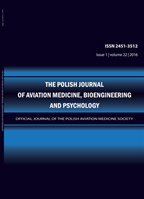2018, Volume 24, Issue 1
EFFECTS OF SELECTIVE COOLING OF SPECIFIC HUMAN BODY SURFACE AREAS ON SUBJECTIVE ASSESSMENT OF THERMAL COMFORT IN HOT CONDITIONS
Anna Przewodzka1, Anna Czerwińska1
-------------------------------------------------------------------------------------------------
1Military Institute of Aviation Medicine
Autor korenspondencyjny: Anna Przewodzka; Military Institute of Aviation Medicine; email: aprzewo2@wiml.waw.pl
Full text
Streszczenie
Introduction: The aim of the study was to determine whether changing the location of a selectively cooled body surface area in hot conditions, using a thermal stimulus of the same temperature and the same area and time of cooling, has an effect the on subjective assessment of thermal comfort.
Methods: The experiment was participated by 12 healthy men who were not accustomed to high temperatures. Conducting a unit study included: a 30 minute period of adaptation to the thermoneutral conditions followed by 45 minutes of exposure to hot conditions (40ºC), including 30 minutes of an uncooled period and 15 minutes of selective cooling of the neck (series I) or sternum (series II) (stimulus temperature: 10-12°C). The thermal state of the body was evaluated three times using the Bedford test: in the 30th minute of adaptation to the thermoneutral conditions, in the 30th minute of exposure to high temperature and in the 15th minute of cooling in hot conditions. Assessment of thermal sensations in relation to the selectively cooled area (neck, sternum) and the assessment of thermal comfort in relation to the whole body were analyzed.
Results: As a result of 15 minutes of cooling, a significant decrease in skin temperature in the neck region was obtained at the level of ∆TskNECK = -2.2 ± 0.1 °C and sternum ∆TskSTERNUM = -1.8 ± 0.1 °C. A positive effect on the subjective assessment of thermal comfort in the whole body was observed in 70% of the participants who cooled the neck area and in 40% of the participants who cooled the sternum area. The positive effect on thermal sensations caused by cooling the neck area was observed in 80% of the participants, and the positive effect of cooling the sternum area was observed in 50% of the participants.
Conclusions: Selective cooling of the neck or sternum area in hot conditions positively improves thermal sensations. The local sensitivity of the skin to low temperatures is greater in the area of the neck than in the sternum. The improvement of subjective assessment of thermal comfort in relation to the whole body was greater after the application of selective cooling on the neck surface than on the sternum. Local cooling of the skin surface with a low-temperature stimulus (10-12ºC) in hot conditions (40ºC) does not cause the feeling of thermal discomfort.
Słowa kluczowe
selective cooling, thermal comfort, thermal sensations, psychophysical state, Bedford scale
